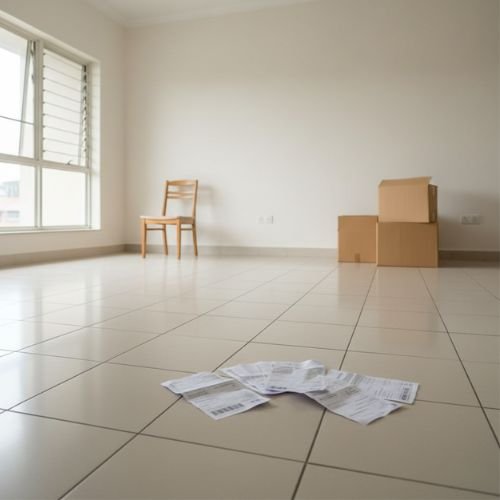When Tenants Won’t Move Out: A Step-By-Step Guide for Malaysian Landlords (Without Self-Eviction!)
Few things worry landlords more than a tenant who refuses to leave at the end of the tenancy.
The keys are not returned, the rent may already be overdue, and the next tenant (or sale) is waiting.
It’s not just frustrating — it can be financially damaging if not handled properly.
And in Malaysia, where we still don’t have a fully implemented Residential Tenancy Act, landlords must rely heavily on the tenancy agreement and proper procedure, not emotions.
The good news? Most overstaying cases can be resolved calmly and professionally when you take the right steps — and when your agreement is clear from the start.
Understand Your Position Before You Take Action
A common mistake landlords make: reacting too quickly.
Yes, overstaying feels unfair. Yes, the tenant is technically in breach.
But there are also things you cannot do under Malaysian law:
- You cannot change the locks.
- You cannot shut off electricity or water.
- You cannot enter the unit without permission.
- You cannot remove their belongings.
These actions can expose you to claims of harassment or unlawful eviction — even if you are the rightful owner.
Your strength lies in documentation, written notices, and the terms of your tenancy agreement.
(And this is exactly why the DIYA bilingual tenancy pack includes clear clauses on end-of-tenancy obligations, notice periods, and vacant possession.)
Step 1 — Re-check What Your Agreement Says
Before taking any action, revisit these sections of your agreement:
- End date of the tenancy
- Notice period required
- Renewal terms
- Vacant possession clause
- Overstay or “holding over” clause
- Deposit rules
If the agreement is vague, enforcement becomes more complicated.
If the agreement is clear, everything you do from here will be on solid ground.
Step 2 — Issue a Formal Written Notice
WhatsApp messages are convenient, but they are not enough on their own.
Send a proper notice (email + WhatsApp + physical letter if possible) stating:
- Your name and the property address
- The tenancy expiry date
- A reminder that the tenant must vacate
- Any outstanding rent or bills
- Proposed dates for joint inspection and key return
- A polite but firm tone
Avoid emotional language — you’re building a paper trail, not starting a fight.
Step 3 — Document Everything
At this stage, documentation becomes your strongest protection.
Keep records of:
- All messages and emails
- Rent arrears
- Missed notice deadlines
- Attempts to arrange handover
- Photos or videos of the unit condition (if you were able to enter earlier)
If the matter escalates, documentation can be the difference between a smooth resolution and a messy dispute.
Step 4 — Try a Final, Clear Extension (If It Makes Sense)
Not all overstays are malicious.
Sometimes tenants overstay because:
- Their new unit isn’t ready
- They misunderstood the notice period
- They’re waiting for deposit refund to secure their next place
- There is a disagreement about damages or repairs
You may choose to offer a short extension with clear terms:
- New move-out date
- Additional daily rental or penalty
- Condition of handover
- Final inspection date
Put everything in writing and get the tenant’s acknowledgement.
This protects you while giving the tenant a fair landing.
Step 5 — If They Still Refuse to Leave: What You Can and Cannot Do
What you CANNOT do:
❌ Change locks
❌ Enter without consent
❌ Remove belongings
❌ Shut utilities
❌ Harass the tenant
(These can be used against you even if the tenant is wrong.)
What you CAN do:
✔ Send a formal letter of demand
✔ Engage a lawyer (if necessary)
✔ File a civil claim for vacant possession
✔ Deduct unpaid rent or damages from the deposit (if properly documented)
Most landlords do not reach this stage — clear communication and a proper agreement usually resolve the issue.
Step 6 — Prevent Overstaying in the Future
Overstaying problems often happen because the initial agreement was unclear, outdated, or copied from random online templates.
Landlords can prevent most issues by:
- Screening tenants properly
- Using clear clauses on vacant possession
- Including penalties for overstaying
- Allowing viewings during the final 30 days
- Conducting mid-tenancy inspections
- Keeping communication polite and documented
- Using a bilingual agreement both sides actually understand
This last point is important.
Misunderstandings often happen simply because the tenant didn’t fully grasp the English legal terminology.
That’s why the DIYA bilingual tenancy pack includes:
- English + BM agreements
- Clear clauses for renewals, notices, deposits
- Step-by-step guidebooks for landlords and tenants
- Practical checklists for handover and inspection
It reduces the chances of disputes — because both sides know exactly what is expected.
Conclusion: Stay Calm, Stay Professional, Stay Protected
A tenant refusing to move out is stressful, but it’s not the end of the world.
With the right documentation, a clear agreement, and a step-by-step approach, most cases can be resolved without conflict.
And as with most things in property management, prevention is better than cure.
A solid, bilingual tenancy agreement and proper communication is still the most reliable way to avoid overstaying issues altogether.






